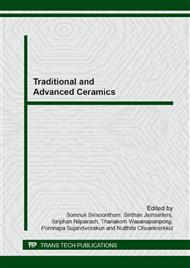[1]
J.A. Boscoboinik, X. Yu, B. Yang, S. Shaikhutdinov, and H.J. Freund, Building blocks of zeolites on an aluminosilicate ultra-thin film. Microporous Mesoporous Mater. 165 (2013) 158-162.
DOI: 10.1016/j.micromeso.2012.08.014
Google Scholar
[2]
S. Bosnar, J. Bronić, Đ. Brlek, and B. Subotić, Chemically controlled particulate properties of zeolites: Towards the face-less particles of zeolite A. 2. Influence of aluminosilicate batch concentration and alkalinity of the reaction mixture (hydrogel) on the size and shape of zeolite A crystals. Microporous Mesoporous Mater. 142 (2011).
DOI: 10.1016/j.micromeso.2010.12.027
Google Scholar
[3]
D. Prasetyoko, Z. Ramli, S. Endud, H. Hamdan, and B. Sulikowski, Conversion of rice husk ash to zeolite beta. Waste Manage. 26 (2006) 1173-1179.
DOI: 10.1016/j.wasman.2005.09.009
Google Scholar
[4]
S. Belkhiri, M. Guerza, S. Chouikh, Y. Boucheffa, Z. Mekhalif, J. Delhalle, and C. Colella, Textural and structural effects of heat treatment and γ-irradiation on Cs-exchanged NaX zeolite, bentonite and their mixtures. Microporous Mesoporous Mater. 161 (2012).
DOI: 10.1016/j.micromeso.2012.05.027
Google Scholar
[5]
V.K. Kaushik, R.P. Vijayalakshmi, N.V. Choudary, and S.G.T. Bhat, XPS studies on cation exchanged zeolite A. Microporous Mesoporous Mater. 51 (2002) 139-144.
DOI: 10.1016/s1387-1811(01)00473-5
Google Scholar
[6]
A. Huang and W. Yang, Hydrothermal synthesis of uniform and dense NaA zeolite membrane in the electric field. Microporous Mesoporous Mater. 102 (2007) 58-69.
DOI: 10.1016/j.micromeso.2006.12.005
Google Scholar
[7]
A.R. Loiola, J.C.R.A. Andrade, J.M. Sasaki, and L.R.D. da Silva, Structural analysis of zeolite NaA synthesized by a cost-effective hydrothermal method using kaolin and its use as water softener. J. Colloid Interface Sci. 367 (2012) 34-39.
DOI: 10.1016/j.jcis.2010.11.026
Google Scholar
[8]
D.E. Jackson, R.A. Larson, and V.L. Snoeyink, Reactions of chlorine and chlorine dioxide with resorcinol in aqueous solution and adsorbed on granular activated carbon. Water Res. 21 (1987) 849-857.
DOI: 10.1016/0043-1354(87)90162-x
Google Scholar
[9]
R.J. Martin and R.C. Shackleton, Comparison of two partially activated carbon fabrics for the removal of chlorine and other impurities from water. Water Res. 24 (1990) 477-484.
DOI: 10.1016/0043-1354(90)90232-u
Google Scholar
[10]
A.A.M. Daifullah, B.S. Girgis, and H.M.H. Gad, A study of the factors affecting the removal of humic acid by activated carbon prepared from biomass material. Colloids Surf., A: Physicochemical and Engineering Aspects. 235 (2004) 1-10.
DOI: 10.1016/j.colsurfa.2003.12.020
Google Scholar
[11]
W. Hao, E. Björkman, M. Lilliestråle, and N. Hedin, Activated carbons prepared from hydrothermally carbonized waste biomass used as adsorbents for CO2. Appl. Energ. (inpress).
DOI: 10.1016/j.apenergy.2013.02.028
Google Scholar
[12]
A. Pak and T. Mohammadi, Zeolite NaA membranes synthesis. Desalination. 200 (2006) 68-70.
DOI: 10.1016/j.desal.2006.03.245
Google Scholar
[13]
S.V. Goryainov, R.A. Secco, Y. Huang, and H. Liu, Amorphization and post-amorphous phases of NaA Zeolite at high P-T conditions. High Pressure Research. 26 (2009) 395-400.
DOI: 10.1080/08957950601092291
Google Scholar
[14]
J.M. Lin and C.M. Ma, Thermal degradation of phenolic resin/silica hybrid ceramers. Polymer Degradation and Stability. 69 (2000) 229-235.
DOI: 10.1016/s0141-3910(00)00068-9
Google Scholar
[15]
X. Zhao, S. Lai, H. Liu, and L. Gao, Preparation and characterization of activated carbon foam from phenolic resin. J. Environ. Sci. 21 (2009) S121-S123.
DOI: 10.1016/s1001-0742(09)60053-x
Google Scholar


